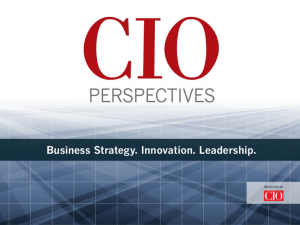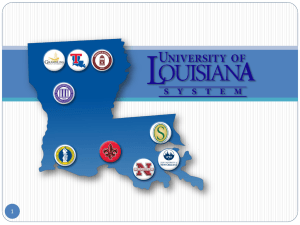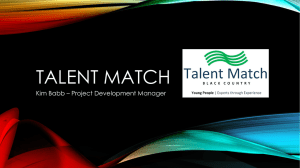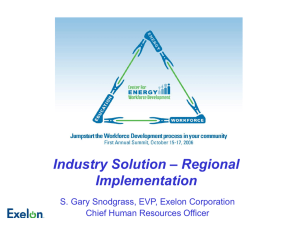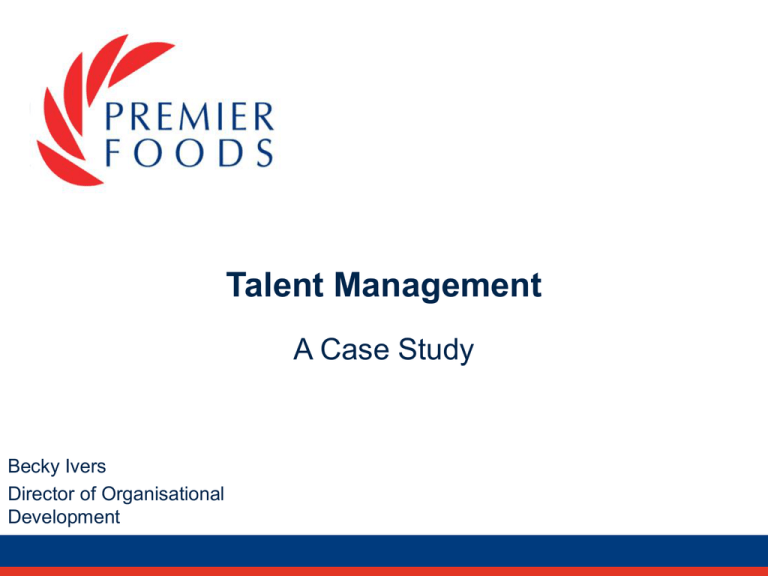
Talent Management
A Case Study
Becky Ivers
Director of Organisational
Development
Outline
•
•
•
•
•
•
•
•
•
•
About Premier Foods
The challenges of 2011
What is Talent Management
The Challenge
The Solution
The Benefits
Benchmarking
Internal Recognition
External Recognition
Q&A
Premier Foods Fast Facts
•
•
•
•
•
•
•
•
Premier Foods is the UK’s largest food producer
UK’s largest branded ambient grocery manufacturer
UK’s largest bread baker and flour miller
Leading supplier of chilled food products
£2.567 billion turnover (year ended 31 Dec 2010)
£311 million Trading Profit (year ended 31 Dec 2010)
Nearly 60 UK and Ireland sites
Approx 15,000 employees
The Best in British Food with Brands You Really Love
4
But.. 2011 has been a difficult year
•
•
•
•
•
•
•
•
•
•
•
•
Board Changes
New Chairman
New CEO
Disposal of Meat Free
Disposal of Canning to Princes
Re-financing
Wheat Inflation
Commodity increases
Weather
Restructure
Negative Press
Share Price plummeting
So What is Talent Management?
DISCUSS!!!!!!!
To us….
“Holistic approach to the development of organisational capability”
The Challenge
•
•
•
•
•
•
•
•
•
•
Acquisitions in 2007 significantly changed the business overnight,
growing from 6,500 to 16,500 colleagues, bringing together businesses
that had and hadn't focused on talent management
There was little awareness of talent or successors
Our first employee engagement survey indicated a dissatisfaction at our
talent and development processes
It was evident through follow up focus Groups that we needed to
develop and implement a company wide Talent and Succession
Planning process
There was a requirement to benchmark all 1200 of our management
population
Little funding and had to be home grown
Could not be systemised due to numerous legacy systems
Needed to reflect best practice and Premier Foods culture
Wanted a business led process not HR led
We needed to change the internal /external balance of selection
The Solution
•
•
•
•
•
In 2008 we developed and implemented the annual Talent and
Succession Management process with very clear outcomes…( just part
of the strategy)
The process was designed in house, with external advise re best
practice
A formal process is conducted annually in May , concluding in a full
Board review. It also forms part of the monthly agenda of business
teams
The executive review gives the organisation an overview of challenges
and based on this, specific development, retention, resourcing and
reward solutions and strategies are developed to address organisational
needs
The process is designed by OD, owned by the line and supported by
HR
Outcomes
•
•
•
•
•
•
•
To ensure the business has the organisational capability to deliver the
business strategy
To identify, retain and develop those considered to be future talent
To develop a pipeline of leaders
To strengthen Premiers employer brand
To identify potential successors for roles
To provide individuals with the opportunity to discuss career aspirations
with their line manager, along with developing a robust development
plan if appropriate
To identify critical roles and options for succession
The Benefits…
•
•
•
•
•
•
•
•
Significant
Led to the development of 2 bespoke solutions to develop our
leadership pipeline
This has resulted in a pipeline of 125 key employees of which 51% have
already been promoted.
Our internal/external ratio has moved from 10/90 to 60/40 which has
improved our employer brand, impacted on retention and productivity
and has had a significant financial impact
We have measured our progress through our engagement survey and
have shown significant improvements and are better than our external
benchmark
Highly action orientated, all actions agreed in 2010 have been
completed, ranging from structural changes, dealing with bespoke
interventions and new initiatives
Enabled us to understand organisational and functional bench strength
Improved retention
Final words
•
The challenge is even greater, even with fantastic brands
•
Impact of social networking
•
Double dip recession
•
Attraction and retention strategies come to the fore
•
Holistic approach is hard!!
A spectrum of existing practice
Developing
Pockets of best practice
Integrated
Cutting edge
Talent
strategy
No plan / initiating
Talent plan aligned to
business strategy
Talent plan essential part of
business strategy
Talent strategy and business
strategy are integrated and
consistent
Business strategy is informed and
influenced by our talent insight and
predictions
Employer
brand
Beginning to develop one
Have a proactive EVP
Employer of choice with clear
value proposition
Are the leading employer of
choice for the talent that we
need now
Able to adjust our employer brand
and employee value proposition to
meet our evolving business and
talent requirements
Attraction
Frequent challenges in getting Sometimes find it difficult to
the right people
attract the talent needed
Able to attract some of the
talent needed, some of the
time
Generally able to attract the
talent needed
No issues; talent availability helps
us advance our goals
Selection
Ad hoc, subjective
Some roles defined, some
solitary line manager views
predominate
Talent discussed through
dialogue in talent forums, (but
little data)
Most talent discussed through Objective talent dialogues permeate
dialogue in talent forums
whole organisation, measures are
includes objective,
calibrated and comparable
benchmarked data
Development
Starting to review ROI
Tactical, isolated,
development
Significant and coordinated,
some ROI
Interconnected and linked to
business strategy and
organisational weaknesses
Flow
Grow
Know
So
Limited
Talent and leadership programmes
deliver tangible benefits to the
organisation and its people
Measurement Few
In place, but little ROI analysis Investments are known, return We know how much we invest We make informed business
often intangible
in talent and what return we
decisions about where we place our
get for that investment
talent investments and are able to
predict the returns
Retention
We typically struggle to retain
our talent
We can retain some of our
talent some of the time
We can retain selected talent
We can retain most of our
talent most of the time
We retain our talent all of the time
and proactively manage turnover
Leadership
HR monopoly
HR leads, senior management Senior manager sponsorship,
supports
HR manages
Talent is a regular item on
senior teams’ agendas
Senior managers devote substantial
amounts of their time to talent;
rewards linked to talent KPIs
Systems
Limited, ad hoc
Some systems have been
independently developed but
don’t ‘talk’
Full suite of efficient, effective
and integrated service
delivery capability
Our systems are flexible and have
industrial scale capacity
© 2009 Hay Group. All rights reserved
Most systems have been
created, rolled out, are
effective and integrated
14
Internal Feedback…
“The introduction of the Talent and Succession Planning process within
Premier Foods has had a significant business impact. Understanding
the capabilities at all levels has enabled us to develop the right people
in the right way, which has ensured the ongoing delivery of our strategy.
In parallel this has provided our employees with meaningful opportunities,
maximising employee engagement “
External Recognition
Personnel Today Awards 2011 Shortlist
Award for Talent Management
BUPA International
Hays
Premier Foods !!!!!!!
Randstad
Standard Life
Tesco
Q&A


